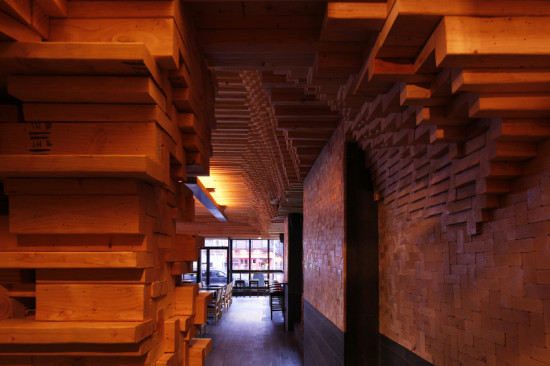
Owner-built interior explores the transition from two dimensions to three.
For his latest venture, The Montrose in Park Slope, Brooklyn, whisky bar proprietor and former contractor Steve Owen (with partners Michael Ferrie and Alex Wade) wanted a rough, industrial look evocative of an Old World distillery. “He was coming at it sort of from an antique perspective, as a pastiche,” said B. Alex Miller, partner at Taylor and Miller Architecture and Design. “We were thinking of it in a different way.” Taylor and Miller, who had worked with Owen on several projects when he was a practicing contractor, noticed the prevalence of wood herringbone patterning on the walls and floors of the spaces Owen was inspired by. “We’d done some other herringbone studies,” said Miller. “We said, ‘This is something that’s often done in a high-end scenario. Let’s pare it down to the barest of essentials, just do it out of 2-by-4 pine, do it in grain on the walls.'”
The design of The Montrose became, said Miller, “a very basic exercise in transitioning from a two-dimensional to a three-dimension pattern,” in which individual boards were pulled away from the wall in the z direction. Working in Rhino, the architects explored multiple iterations of the form, including the different textures created when a unit was defined as a single stick versus a two-board L. The ceiling, along which boards are arrayed lengthwise, also received a three-dimensional treatment. “There were some really interesting relationships in the ceiling,” observed Miller, “almost like a musical score.”
- Fabricator Steve Owen
- Designers Taylor and Miller Architecture and Design
- Location Brooklyn
- Date of Completion 2013
- Material pine boards, nails, screws
- Process Rhino, hanging, hammering, drilling
Though the herringbone patterning was developed almost entirely on the computer, Taylor and Miller wanted to avoid the sense of an overly precise, machine-made space—hence the use of standard lumber. “We’re often looking at very basic materials, at how to do it in a repetitive way so that the human intervention is felt,” said Miller. “We wanted to make it a little more than a highly fabricated, laser-cut, pristine sort of thing.”
Owen built The Montrose’s interior himself. “Because he was a friend, and a contractor, we could remove a lot of the documentation that would normally be required,” said Miller. In fact, Owen soon abandoned the digital models Taylor and Miller passed along. “Once he figured out the system, we were able to give him just data points, just coordinates,” said Miller. “It was a feedback loop: he was interpreting what we gave him. He said, ‘Okay, just give me the z data off the wall.’ We joked that he was seeing the Matrix a little bit.” The installation itself was “dumb, in a good way,” said Miller, requiring nothing more than nails and the occasional screw. “When we’re doing something like this that we know is hyper-labor-intensive, it can’t be complicated from an install point of view. There’s nothing overly polished; it’s just dirty.”
That messiness is exactly what Miller most appreciates about the finished product. “When we go in there now, some of the curves are a little bit rough,” he said. “You can see these—they’re mistakes, frankly, but I love the space because of it. This is not a highly precious thing, this is not a highly sculptured piece. It’s someone interpreting our concept.”